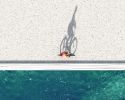World's greenest cruise ship was discussed in Gothenburg

Peace Boat is one of Japan's largest civil society organizations and operates on a cruise ship sailing around the globe, advocating Agenda 2030 and the UN's sustainability goals as well as educators in sustainability, multicultural communication, research, promotion and entrepreneurship. Now the work is ongoing to build the organization's new flagship, Ecoship - the world's greenest cruise ship. Tomas Kåberger, Chairman of the Japan Renewable Energy Foundation and Professor at Chalmers, is one of the project's key advisors.
Four years ago, Yoshioka Tatsuya, founder and head of the Peace Boat and Ecoship Project, visited Lighthouse and Chalmers in Gothenburg to discuss the possibility of building and operating environmentally friendly ships. Now he returned, together with Maria de la Fuente, Co-Director of the Ecoship Project, and Andrés Molina, Shipbuilding Project Manager. Attendees from Chalmers and the Department of Mechanics and Maritime Sciences were Angela Hillemyr, Henrik Pahlm, Lennart Josefson and Per Lövsund, and from Lighthouse, Åsa Burman. At the meeting, respective activities were presented focusing on what Ecoship Project entails and possible opportunities for collaboration, and hopefully, continued with Swedish participation.
An average cruise ship carries 3000 passengers and generates 80,000 liters of sewage daily according to the Environmental Protection Agency, EPA, and many cruise lines use out-dated filter systems. It is also common for large ocean liners to still use bunker fuel. The Ecoship project aims to challenge the status-quo and build a low-carbon cruise ship with innovative technical solutions that will be a model for what the maritime sector can achieve.
A number of strict environmental targets have been set up, including CO2 reduction by 40% compared to a cruise ship built before 2000, and an estimated 30% reduction compared to current cruise ships.
It is expected that the Ecoship will run on 4 different fuels, LNG, Bio-gas (methane), MDO and bio-diesel from non-edible crop by-products. These fuels will cover 95% of the propulsion needs and 60% of the hotel load needs, the rest being covered by renewables or waste energy re-use. However, as research progresses, the ship has been designed to allow cost effective retrofitting for new upcoming technologies. In addition, the vessel will be equipped with ten retractable sails, ten wind turbines and large areas with solar panels in order to become as energy efficient as possible. The Ecoship Project is committed to a target of zero discharge and close to zero waste operations and will incorporate closed-loop waste and water management systems.
Originally inspired by the shape of the whale (inverted bow or equivalent), the hull has undergone parametric modelling using the most advanced techniques with special emphasis on savings and hydrodynamics. Experts believe that an appropriate hull shape could result in up to a 5% reduction in fuel consumption.
Work on Ecoship began in 2014 and this spring, a letter of intent was signed with the Arctech Helsinki Shipyard to build the ship. By spring 2020, the ship is supposed to be ready.
Read more about Ecoship here: http://ecoship-pb.com/

-
 We are not approaching the transport policy goals
We are not approaching the transport policy goals -
 Time to pave the way for ammonia
Time to pave the way for ammonia -
 Norwegian officers skeptical of autonomous ships
Norwegian officers skeptical of autonomous ships -
 Drones and AI can save lives at sea
Drones and AI can save lives at sea -
 Watch the seminar Nordic Roadmap
Watch the seminar Nordic Roadmap -
 Research money yields manifold returns
Research money yields manifold returns -
 Bike counting at docks could save fuel
Bike counting at docks could save fuel -
 Hydrogen to be cooled with seawater on Gotland ferries
Hydrogen to be cooled with seawater on Gotland ferries -
 New rules needed for handling electric cars on board ships
New rules needed for handling electric cars on board ships -
 ChatGPT lacks spatial sense
ChatGPT lacks spatial sense

